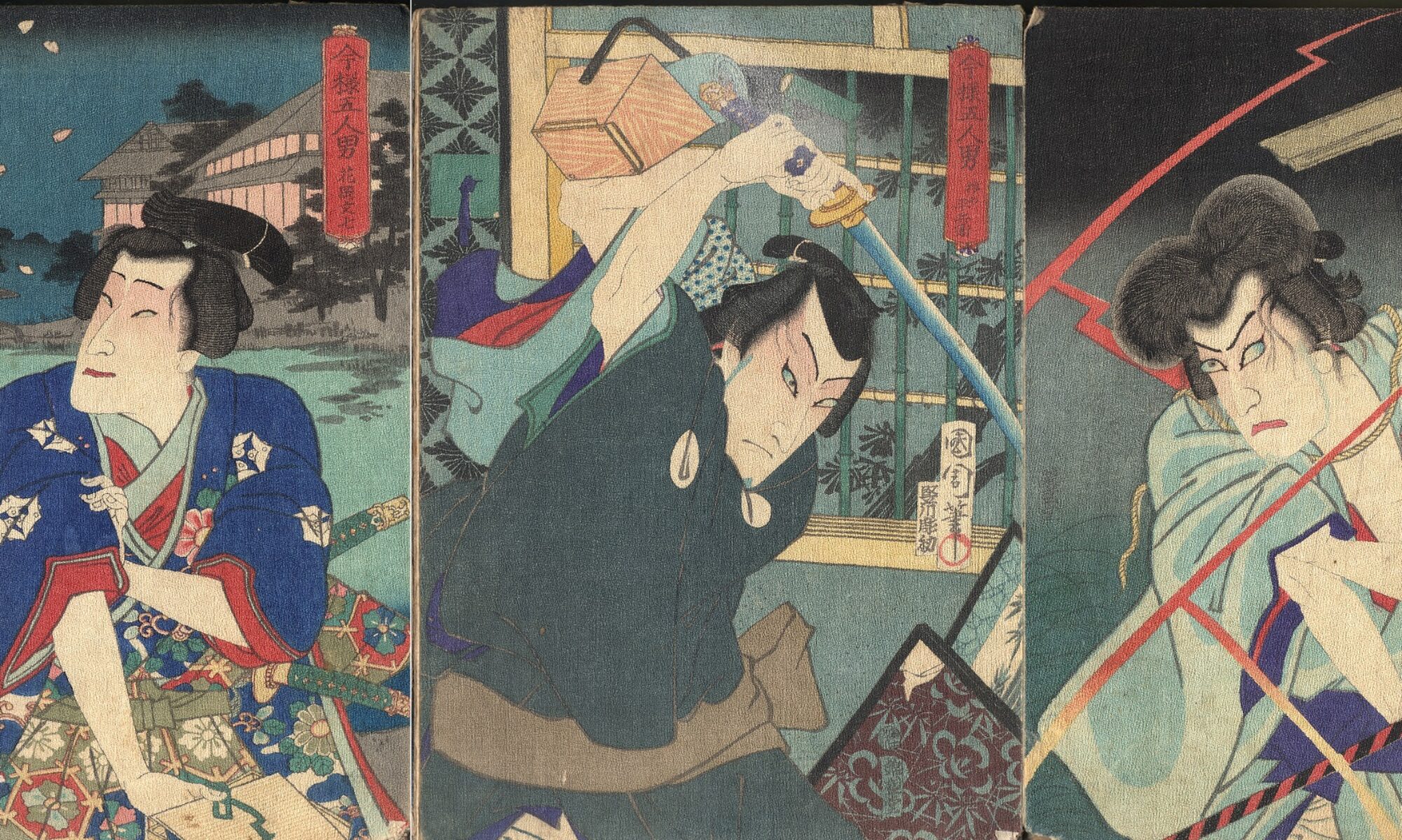Regarding the period from 1852 to 1870, the following was discussed: Changes in the artist’s surname before taking the name Kunichika Toyohara, Seal other than ToshidamaStamp, Ohkubi-e, Ohkao-e, compositions such as medium shots, emotional expressions, manga with exaggerations and omissions, storytellers, etc. Here are some additional items that are being considered. The main text may be rewritten depending on the content here.
.
Toyohara Kunichika Was a Subculture Ukiyo-e Artist
Ukiyo-e spread across the world and is now preserved in numerous museums in countries such as the United States, the United Kingdom, and France. In terms of the number of prints held in collections worldwide, Utagawa Kunisada (Toyokuni III) ranks first with 27,000 sheets, Hiroshige follows with 11,000, Kunichika is third with 10,000, and Kuniyoshi has 4,000. These figures are regarded as evidence of the popularity of these artists during their lifetimes.
Actor prints, among other genres, were originally not created as works of art in the strict sense, but rather functioned as printed media for conveying kabuki plays through the vehicle of ukiyo-e. As Hideyuki Iwata and others have noted, there is now a growing recognition that ukiyo-e served as a form of popular media. (Hideyuki Iwata & Shotaro Koike, Yakusha-e no Zuzougaku: Nishikie Hakkenden o Yomu, Bungaku Tsūshin Co., 2024).
While certain ukiyo-e have come to be evaluated as works of art, Kunichika’s oeuvre was examined within this evaluative framework to determine whether any of his works might be similarly recognized. However, the prevailing conclusion was that he was merely an artist who inherited the mass-production tendencies of Toyokuni, producing works in great quantity without notable refinement.
From the conclusion of this study, it can be stated that Kunichika depicted kabuki actor portraits as a form of subculture; moreover, his mode of depiction had attained a level equal to, or even surpassing, that of modern visual techniques, thereby effectively conveying the appeal of kabuki to the common populace.
At What Age Did Kunichika Become a Disciple of Toyokuni III?
The interpretation most widely accepted today is based on an interview article published in the Yomiuri Shimbun in 1898 (Meiji 31) as part of the serial “Meiji no Edo-go,” which was later introduced by Mori in “Kunichika to sono Seikatsu” (Ukiyoe Geijutsu, no. 20, pp. 20–25, 1969; see ref. 17). In it, Mori cites Kunichika’s own words:
“I, too, decided to try my hand at oshie (padded relief pictures), so I became a pupil of Ichiyūsai Chikashige; this was essentially my initial training. After that, I became a pupil of the second-generation Toyokuni… Toyokuni was the man popularly known as a master for his illustrations to Inaka Genji, but I trained there for exactly seventeen years.”
From this account, Mori inferred: “By counting back from Toyokuni III’s year of death (Genji 1 [1864]), Kunichika likely became his pupil in Kaei 1 (1848) at the age of fourteen. In that case, he would have studied under Toyokuni III for seventeen years until the latter’s death in Genji 1.” Because this conclusion is grounded in Kunichika’s own testimony, the prevailing view today holds that he entered Toyokuni III’s studio at the age of fourteen. The strength of this theory lies in the fact that it is based on a statement made by Kunichika himself in 1898, but ultimately it remains an inference.
A second theory is advanced by Sekine Tadamasa (Utagawa Kunichika, Ukiyoe Hyakkaden, p. 121, Rokugōkan, 1926):
“At the age of fifteen, he entered the studio of Ichiyūsai Chikashige (popularly known as Toriyama Shinji) and, under the name Katsunobu, became skilled at producing oshie portraits of actors for battledore decoration. At the age of seventeen, on the recommendation of others, he became a pupil of the third-generation Toyokuni…”
Kojima Chōsui relates essentially the same account:
“According to one account, at the age of fifteen he entered the studio of Ichiyūsai Chikashige (popularly known as Toriyama Shinji), and under the name Katsunobu produced original actor portrait designs for oshie. On the recommendation of others, at the age of seventeen he entered the studio of the third-generation Toyokuni…”
(Futatabi Kunichika no Kotodomo, Ukiyoeshi, vol. 6, no. 23, pp. 2–7, Unsōdō, November 1930). Kojima’s wording closely resembles that of Sekine, suggesting that it may have been a direct quotation. Sekine’s account appears to carry some credibility, given that it was published relatively early—only twenty-five years after Kunichika’s death, in 1925—but its weakness lies in the phrasing “according to one account…,” which leaves the evidentiary basis ambiguous.
